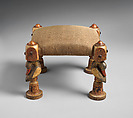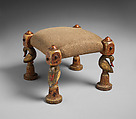Stool
Designer Lockwood de Forest American
This stool exemplifies the fascination with exotic styles that characterizes the Aesthetic movement. De Forest’s personal love of such styles influenced him to collect artworks from and travel to locations such as India. His appreciation of the craftsmanship he observed in the workshops of Kashmir prompted him to open a workshop in Ahmedabad in 1881.
This rare stool is an excellent example of the marriage of Eastern technique and decoration with a form native to the West and intended for the Western marketplace. The stool’s legs are like those of Indian "charpoys" (four-footed beds). When in Kashmir, de Forest saw carved charpoy legs in the shape of ducks, which inspired him to have copies made and painted in the Kashimiri tradition, using gold leaf and overlaid floral patterns. At least two stools with these legs survived. Both have descended through the de Forest family.
This image cannot be enlarged, viewed at full screen, or downloaded.
This artwork is meant to be viewed from right to left. Scroll left to view more.





